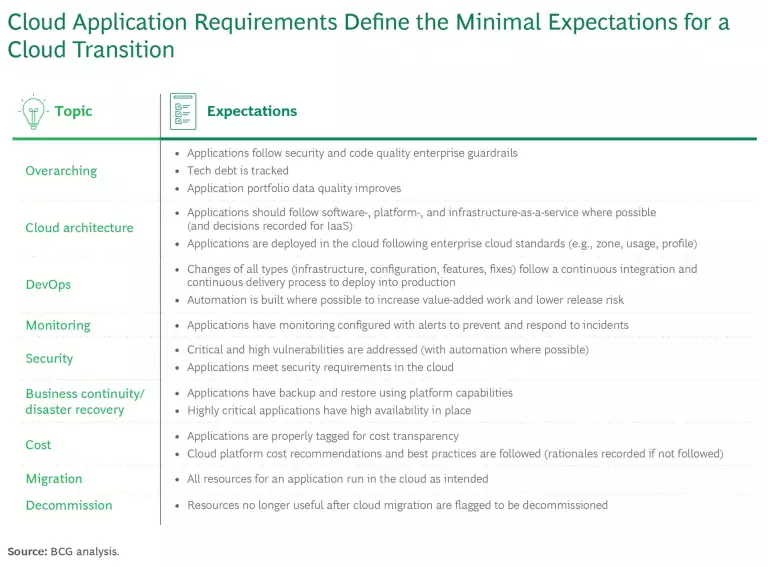For many companies, a cloud transformation is a critical step in their digital and AI journey. Public cloud can yield compelling benefits, including greater agility for faster time to market with global reach and scale, more efficient delivery of digital products and services at lower cost, and improved resilience and security. Moreover, having access to the cloud provider’s most cutting-edge digital, AI, and platform services allows public cloud customers to focus on innovating their business instead of their technology.
Unfortunately, many companies struggle to achieve these benefits because they don’t identify problems in their cloud transformations soon enough. More than half of all transformations fail to achieve their intended benefits within three years. For a typical large company, this represents a loss of hundreds of millions of dollars. Moreover, once a transformation goes off track, research shows that it’s very difficult to turn it around.
With the recent wave of innovation in AI and generative AI technologies, the stakes are getting high for companies that cannot transition to the cloud and leverage these new tools. BCG’s work with clients on several cloud transformations has enabled us to identify six signals that can help flag problems early on—and six interventions to turn around a struggling transformation.
Six Signs of Trouble
When a cloud transformation has one or more of the following six characteristics, that’s a strong signal that it’s gone off track. The more signals, the greater the risk that the transformation will run over budget, miss deadlines, and fail to achieve its intended benefits.
- Clear cloud transformation goals, agreed metrics, or milestones are absent (or early milestones are missed). This signal often indicates poor alignment among stakeholders, tepid business buy-in, misaligned incentives, or a lack of execution rigor.
- Sequencing of the migration is not centrally managed. Without a centralized overseer, IT teams will scope and sequence their cloud migrations independently of one another. Migrating workloads without assessing their strategic importance, future relevance, or technical complexity leads to technical challenges, failed migrations, rework, and additional cost.
- Cost controls are lacking. It’s a danger sign if the costs of applications that have been migrated to the cloud are increasing faster than inflation. This indicates that important cost controls or automated mitigations are not in place.
- Minimum cloud skills are undefined or a coordinated training program is not available. When applications move to the cloud, the operational responsibilities of their application teams increase. Companies need to clarify these responsibilities and offer the appropriate upskilling. If they don’t, operational instability, increased costs, and security issues are all a risk.
- Technical standards are missing or not followed. To ease the transition for teams and secure their buy-in, some companies choose not to enforce technical standards. But this ultimately leads to expensive, unnecessary complexity and cost.
- Applications are primarily migrated to infrastructure-as-a-service. This is a signal that the company is too focused on moving applications and workloads to the cloud as is (known as application lift and shift). This can be a legitimate first step in a cloud transformation, but if infrastructure-as-a-service is the end goal, the company won’t achieve the cost benefits of flexible scaling. The company is likely to incur unnecessarily high cloud costs, create technical debt, and even worsen security risks. Research shows that cloud transitions, when executed as part of a broader business transformation, generate 12 to 15 times the benefits of a purely infrastructure-focused transition.
Six Turnaround Interventions
Faltering cloud transformations are notoriously difficult to turn around because of constant business requests that distract the application teams from transformation-related tasks, inflexible system integrator contracts that don’t allow for subsequent needed work, and the tendency to continue using execution strategies even after they have proven ineffective.
Six interventions can address the most common root causes of a transformation’s problems. Depending on the program, one or more of these interventions may be needed.

Implement a control tower. A control tower defines the intended benefits of the cloud migration and communicates these expectations clearly to application teams. An important part of this implementation is to define the technical standards—the cloud application requirements in nine topic areas—used to measure the quality of the cloud program. (See the exhibit.) Companies often believe they have these requirements in place, but in reality few define them systematically or with enough specificity to focus application teams on the right goals and standards.
Besides setting expectations and defining standards, the control tower appoints a design authority (composed of several individuals) to assist with execution. The design authority partners with the application teams to determine what work is needed on which applications. In practice, the amount of work needed on each application will differ greatly by application, depending on usage, criticality, and business value. It helps to have a central authority define the scope of work by application, sequence the migration to optimize business value, and closely monitor costs. Financial transparency helps prevent double-run costs and flag avoidable recurring cloud costs.
Specify changes in roles and responsibilities for development and operations. The responsibilities of application teams, platform teams, and the infrastructure provider change significantly after a cloud transition. Some companies underestimate the magnitude of these changes, assuming that teams will be able to figure out their new responsibilities. For example, in the precloud environment, many companies use specialized IT operations or data center teams to manage most application operations activities. But since cloud providers don’t step in to take over that role, operational responsibilities after the migration typically land on the application teams, which will probably need new skills. Additionally, infrastructure operations teams will need to transform into cloud platform teams, providing on-demand self-service and end-to-end automation instead of operations services. This requires a major shift in the service portfolio and skill sets. It’s very important that the new operating model clearly define, up front, the responsibilities for developing and operating products and services on the cloud.
Define minimal cloud skills and establish an upskilling program. Achieving cloud benefits is only possible if companies establish minimal skill levels and give employees the proper training in the new tools and platforms so they can set up the applications and environments. Unfortunately, companies often underinvest in training. What’s needed are formal upskilling mechanisms or programs for different roles, with a standard curriculum per role to ensure that employees can maintain applications after the migration. Vendors also need to set minimum standards (such as certifications) to ensure that their employees have sufficient knowledge to develop and operate on the cloud. In fact, companies must demand educational standards from their vendors, especially when they are providing their own employees to help with the applications.
Launch a technical accelerator program. It’s rare for application teams to have a deep familiarity with the cloud, and it’s even more unusual for them to have hands-on cloud migration know-how. This inexperience can delay the migration or cause teams to make choices that add costs or create security risks. A technical accelerator program provides outside cloud engineers and migration specialists who can help application teams migrate the applications to the target cloud.
It’s very important that the new operating model clearly define, up front, the responsibilities for developing and operating products and services on the cloud.
In practice, many models exist to support application teams with their cloud migration. One is to create so-called accelerator teams that help multiple application teams complete their respective cloud migration activities. This can help improve productivity, cost efficiency, and the overall quality of the migration.
Implement a cloud FinOps capability. Application teams new to cloud often don’t know how to manage cloud cost control. This is why many companies choose to implement a cloud FinOps capability, usually as a small, separate team. The team helps make the drivers of cloud costs visible, so application team members better understand where their cloud costs are coming from and why the company is incurring them. Usually, the FinOps team provides this information through automated dashboards and some specialized tools that can intelligently redirect application teams to more cost-effective options. The FinOps team can also advise application teams on ways to better control and rationalize costs—by choosing different tiers of cloud services, for example. Finally, the FinOps team may engage in cloud cost benchmarking to identify cost improvements.
Build in automation for continuous intervention. Continuous maintenance and monitoring are critical to ensure that policies and best practices are followed. Through automation and company-wide policies, companies can enforce consistency and rapid rollout of new requirements. Automation and tooling are key to ensure that cloud scaling is executed properly and cloud costs don’t grow out of control.
The New Approach in Action
One client recently used these signals and interventions to turn around a transformation that had been underway for four years and was stalling. The company had slightly more than half of its apps on the cloud, but digital delivery was slowing down while incidents and costs were going up.
The approach allowed the company to fully complete its migration backlog over a period of 18 months. It ensured that all of its cloud applications met availability and quality targets (improving agility) and reduced run costs of previously migrated applications by over 10%. It began upskilling nearly all of its tech workforce and improved resilience and compliance by removing all material security vulnerabilities, bringing the average security score of the applications from below what’s required to about 80% (an above-average score).
Turning around a cloud migration that has veered off track and is failing to deliver benefits is difficult but critical in today’s competitive environment—even more so as companies scramble to leverage the most cutting-edge AI tools. The first step is recognizing as early as possible whether a migration is struggling. When a turnaround is needed, the six interventions described here can efficiently refocus the organization’s effort and get the migration back on track for maximum value.






